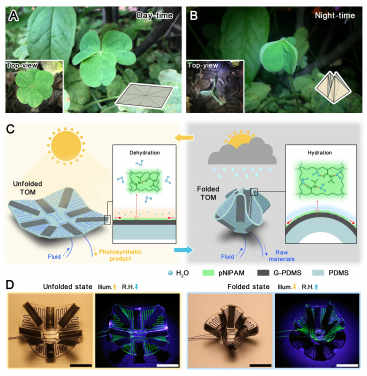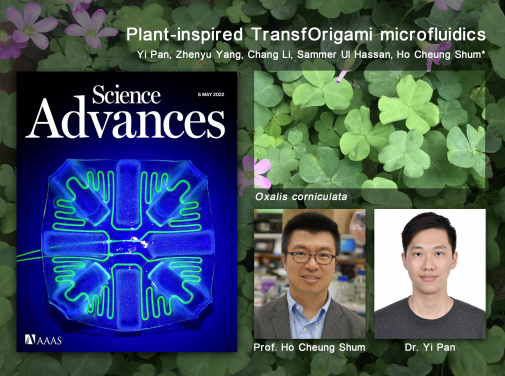Media
HKU researchers develop transformable 3D origami microfluidics
inspired by clover plant
12 Jun 2022

Oxalis corniculata at its (A) open state during the daytime and (B) close state during nighttime. Left insets: Top view of its open and close states, respectively. Right insets: Unfolded and folded states of the corresponding origami structure, respectively. (C) Schematic drawing of the TOM at its unfolded state when the temperature is high and light irradiates; folded state when the temperature is low and humidity is high. The insets show the schematic dehydration and hydration in the pNIPAM hydrogel layer of the actuating unit at the unfolded and folded states. (D) Bright-field images (channel is filled with blue dye) and dark-field images (channel is filled with fluorescent dye) of TOM’s two states. Scale bars, 10 mm.

The paper “Plant-inspired TransfOrigami microfluidics” has been featured on the cover of Science Advances for May 6 2022 issue. The research team (from left) Professor Anderson H.C. Shum and Dr Yi Pan from the Department of Mechanical Engineering, HKU. The background image is Oxalis corniculata.

Oxalis corniculata at its (A) open state during the daytime and (B) close state during nighttime. Left insets: Top view of its open and close states, respectively. Right insets: Unfolded and folded states of the corresponding origami structure, respectively. (C) Schematic drawing of the TOM at its unfolded state when the temperature is high and light irradiates; folded state when the temperature is low and humidity is high. The insets show the schematic dehydration and hydration in the pNIPAM hydrogel layer of the actuating unit at the unfolded and folded states. (D) Bright-field images (channel is filled with blue dye) and dark-field images (channel is filled with fluorescent dye) of TOM’s two states. Scale bars, 10 mm.
- 1 / 2
- 2 / 2
Living creatures have inspired many fascinating engineering designs, keeping the scientific community on the lookout constantly for the next novel idea. This time, the crossover between biology and technology features the clover plant (Oxalis corniculata) – usually considered as a weed in flowerpots – as the protagonist.
Engineering experts at the University of Hong Kong (HKU) were inspired by the nastic movement of clover that led them to develop an origami microfluidic device that can respond to changes in the environment, such as temperature, light intensity, and humidity.
The research team, supervised by Professor Anderson Ho Cheung Shum and led by Dr. Yi Pan from the Department of Mechanical Engineering at HKU, embedded stimulus-responsive materials into a thin elastomeric microfluidic device to accomplish the device’s responsiveness to temperature, humidity, and light.
By designing it into a foldable geometry, the responsive movement of the device follows the preset origami folds. This innovative engineering design has been published in Science Advances and featured as the cover story of the renowned academic journal.
The research team named the transformable microfluidic device ‘TransfOrigami microfluidics’ (TOM) to emphasize the close connection between its transformation and the origami structure. The breakthrough is of great significance to realize the environmental responsiveness of microfluidic devices in the future.
Microfluidics is an evolving multidisciplinary field that studies systems responsible for manipulating and processing tiny amounts of liquid. Among other fields, the precision medicine approach will benefit from this invention as important biomedical applications from drug delivery to tissue engineering can be facilitated through microfluidic devices.
Notably, the microchannel structure of microfluidic devices was confined to a 2D plane for many years. The development of TOM by the HKU research team shows a one-of-its-kind 3D microfluidic structure that responds to environmental stimuli by folding like a clover plant.
“TOM can be used as an environmentally adaptive photomicroreactor. It senses the environmental stimuli and feeds them back positively into the microfluid that is undergoing photosynthesis through the morphological transformation,” said Dr. Pan.
“When the external environment is suitable for photosynthesis, for example, on a sunny day, the device unfolds to promote photosynthesis. When the external environment is not conducive to photosynthesis, such as on a rainy day, the device folds to slow down the photosynthesis,” he added.
The principle can be further extended to applications such as dynamic artificial vascular networks and shape-adaptive flexible electronics.
“As we know, living organisms are normally dynamic and have a certain moving rhythm. When the developed organ chip is equipped with the function of responsive movement, it will be closer to the real living organism, which may help us to simulate the function of organs in microfluidic devices (organs-on-chips) more effectively,” said Professor Shum.
A dynamic artificial vascular network will be a potential combination of TOM and organs-on-chips while shape-adaptive flexible electronics will be a combination of TOM and flexible electronics.
“The surface of the human body is mostly curved. In wearable flexible electronics, the surface conformity between the device and the human body will affect the efficiency of signal induction. If the flexible electronics can deform in response to the stimulus, they may help the device to transform better into the shape of human body surface to improve the performance of flexible electronics,” Professor Shum added.
Synthetic microfluidic systems are usually made with conventional fabrication materials, but they have rarely demonstrated the same environmental responsiveness as plants. If microfluidic systems had the ability to transform in response to stimuli, it would pave the way for more sophisticated, multifunctional, or even intelligent fluidic systems. Therefore, the research team implemented the nastic movement of clover in a microfluidic device.
“Plants have evolved in their ability to respond to environmental changes to survive. This allows their vasculatures, the network through which plants transport water and nutrients, to function healthily even in an ever-changing environment. This vasculature has inspired scientists to develop artificial systems with embedded fluidic channels, such as biomimetic microfluidic devices,” said Professor Shum.
He believes that this is a fantastic illustration of how humans can follow nature’s inspiration to facilitate technological design.
The research team is committed to solving more mysteries about soft matter, microfluidics, and beyond. This study has pioneered the use of plant-inspired morphing origami microfluidics to achieve adaptive photosynthesis.
The paper entitled “Plant-inspired TransfOrigami microfluidics” is published in Science Advances. Link: https://www.science.org/doi/10.1126/sciadv.abo1719
Video link
Media Enquiries
Ms Celia Lee, Faculty of Engineering, HKU (Tel: 3917 8519; Email: leecelia@hku.hk) or Ms Charis Lai, Faculty of Engineering, HKU (Tel: 3917 1924; Email: chariskc@hku.hk)
